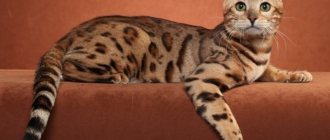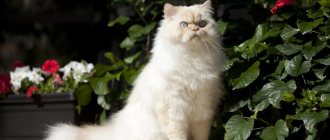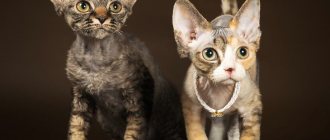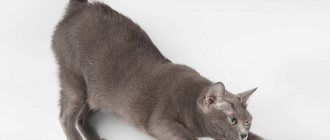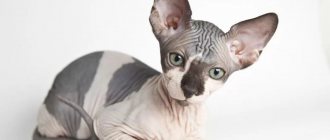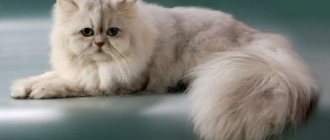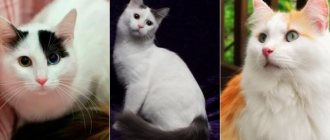History of Lykoia
Lykoi was first created in America, Virginia. Patti Thomas managed to breed them in 2010 from the union of two mongrel cats. Having looked at the features of the skin of her new kittens, the owner initially decided that they were caused by either a disease or a defect. However, after examination by veterinarians, this version was rejected, and Patty turned to two large breeders, Johnny and Britney Gobble. Together, they established that the peculiar appearance of the Lykoi cat is a recessive trait that is lost in the offspring when they try to mate with other cats. Next, the team conducted DNA testing at the University of California, Davis, to definitively determine whether the Lykoi had the genes of the short-haired Sphynx cat. The result was negative. In 2011, a second pair of naturally bred Lykoi was found, but this time in Tennessee.
The peculiarity of the Lykoi coat is a recessive trait.
So, in 2012, TICA (International Cat Association) officially registered a new cat breed called Lykoi, which means “wolf” in Greek. The name was chosen by Patti Thomas, who is rightfully considered their “progenitor”.
However, recognition of the Lykoi as a new breed is not universal; the CFA (Cat Fanciers Association) has not yet registered this breed, even as a temporary one.
Appearance
This is a unique breed of cat with large, intelligent, predatory eyes, an almost bald face and long, wolf-like hair. If you decide to get such an unusual kitten, many discoveries await you and you will be guaranteed the attention of others.
The body structure of werecats is similar to the Canadian Sphynx, plus the same small head and huge ears. The eyes of these phenomenal animals are incredibly huge and far apart, in the dark it is a real cat demon.
Description of the breed
Lykoi undoubtedly have a specific appearance that is well remembered. The breed has a unique color among cats, which, combined with the partial absence of hair on the face, makes them look like werewolves.
Appearance
As with all other registered breeds, TICA gives clear standards for the appearance of the Lykoi.
Table: TICA standards
| Parameter name | Description |
| Head shape | A modified wedge with rounded contours, running from the nose to the cheeks and then to the ears. Slightly rounded forehead. Longer than wide. |
| Ears | Large, wide at the base and pointed at the tips. Located vertically, high on the head. May be bald with some sparse hair on the outer surface. |
| Eyes | Medium size, oval, almost round. The inner corner points to the nose, the outer corner points to the outer edge of the ear. Due to the absence of hair, a contour is formed around the eyes. Gold color is preferred. |
| Muzzle | Medium length, fleshy cheeks with softly rounded, lint-free whisker pads. There is a hairless mask connecting the muzzle, chin, nose, ears and eyes. |
| Chin | Well developed, aligned vertically with the nose, full, round. |
| Nose | The nose is bare and leathery to the touch, slightly rounded at the end. |
| Profile | A concave curve from the forehead to the bridge of the nose. |
| Neck | Average length. Neither thin nor overly muscular. |
| Torso | Foreign type. |
| Musculature | Flexible, slender. The muscles are solid, without excess mass. |
| Limbs | With receding hairline, medium length. Paws are medium in size and oval in shape. The fingers are long. |
| Backbone | Average. |
| Tail | Shorter than the body and tapering towards the tip. |
| Wool length | Short to medium. |
| Wool texture | Partially naked. The undercoat is minimal, with longer hairs covering the body. The volume of fur will vary depending on the shedding cycle. In appearance it resembles possum fur. Soft to the touch. |
| Coat color | Dark black or black-brown, mixed with white in a ratio of 70 to 30. |
Defects:
- absence of a bald mask on the face;
A distinctive feature of the Lykoi is the bald mask on the face.
- absence of characteristic bald patches on the animal’s body in the paw area;
- color discrepancy (with this defect, animals are allowed only for breeding).
Video: demonstration of the Lykoi breed
Character
Likoy, like a real wolf in the skin of a cat, is a born hunter. In nature, he will be actively engaged in catching small animals, but at home he will have to close the cages of rodents and birds, as well as isolate the aquarium. But this property guarantees the future pet’s love of entertainment and joint evenings with the owner playing with a rustling bag.
Due to their active nature, it is better not to walk Lykoeis without a harness.
However, this does not mean at all that they are unaffectionate pets, quite the opposite. This cat breed is very friendly and loves to be the center of attention. When meeting strangers, Lykoi first behave warily, trying to find out whether the new person or animal poses a threat to him or the owner, and then relax and calmly make contact. Therefore, having a Lykoi at home does not mean that this pet should be your only one.
Lykoi are very loyal pets, but when left at home alone, they do not start “howling at the moon”, but find something to do and calmly wait for the return of their beloved owner. Moreover, due to their high intelligence, these cats are easy to train.
Health
The diseases of Lykoi have not yet been fully studied, but it is known that in general the animals can boast of fairly good health. There is no information about the presence of genetic diseases. However, there are also no guarantees of their absence.
Breed Features
Lykoi have an extremely specific appearance, which not everyone is ready to appreciate, but at the same time they know how to tie people to themselves. So, having overpowered himself and taken him in his arms, after a short time a person will begin to be guaranteed to enjoy communicating with the little wolf. Whether this is a feature or not is up to you to decide, but not every short-haired cat is capable of this.
Mostly roan-colored Lykoi are found: black soft hair mixed with coarse white hair
Wool
At the University of Tennessee, dermatologists examined them for skin pathologies. Further, based on skin biopsies, dermatologists could not find any similar hair samples. And they discovered that some of the necessary hair follicles were missing for hair growth (which is why Lykoys lack an undercoat). They also discovered that the follicles that were able to produce hair lacked the proper balance of these components to support hair growth (which is why Lykoi molts and can sometimes become almost completely bald). Through test breeding it was determined that this was a true natural mutation.
Maintenance and care
An important point in keeping Lykoi is caring for their coat. Due to the fact that cats of this breed are partially hairless and have an active temperament, a coating of sweat appears on the Lykoi's skin. It is necessary to regularly clean bare skin with wipes or wash your pet. However, the animal may oppose the last procedure due to fear of water, so it is worth teaching the Lykoi to bathe from childhood.
Bare areas of the cats' skin will need to be cleaned of sweat using wipes or bathing.
The reaction of the Lykoi skin to the sun and heat is associated with the peculiarities of incomplete coverage of the body with hair. When staying near a source of heat or under the sun's rays for a long time, the skin of this breed becomes covered with dark spots or even turns black. However, by eliminating the source of high temperature or limiting walks, skin color is restored.
In addition to the above, the presence of bald patches characteristic of this breed makes Lykois susceptible to cooling. In this regard, their beds should be placed in warm places, away from drafts.
The remaining tips are general for all breeds and are in no way related to the specifics of keeping Lykoi at home:
- If there are leaks from the eyes, you need to wipe them with a cotton pad soaked in water. Tea leaves cannot be used.
- If there are dark deposits in the ears, you need to wash them with a special lotion, and then let the cat wipe it off or blot it on its own with a cotton pad. Do not use a cotton swab for cleaning. This is due to the specific structure of the auricle in cats, due to which the owner can only reach half of it, as well as irritation of the special glands responsible for secretion in the ear, which causes a reverse reaction.
- You need to monitor the length of your cat's claws. If your pet can’t handle trimming them on his own, then you need to cut them off as they grow back. For this, special forceps are used. You only need to cut off the curling part of the nail, a couple of millimeters from the pulp (the pink part of the nail). However, this is a radical intervention; first you need to provide the animal with a scratching post.
Like any other cat, Lykoya needs to be provided with a scratching post.
- For kittens, you need to use a toilet with low sides, since climbing onto a high one will cause them significant difficulties. For an adult cat, choose a potty that takes into account the size and weight of the animal.
To feed Lykoi, it is better to select food from well-known manufacturers based on coat type or for active pets.
Table: pros and cons of the breed
| pros | Minuses |
| Unique appearance | Special care required |
| High intelligence | Highly developed hunting instinct |
| Ease of maintenance | High activity |
| Loyalty to the owner | Extremely high cost |
| Friendly to people and animals | Difficulty in purchasing a kitten |
| Independence |
How long do they live and what diseases do they suffer from?
Up to three months of age, kittens must be vaccinated against a whole range of diseases.
The cat, which looks like a werewolf, has no diseases and is in enviable health. This is due to the fact that the breed is very young and their DNA is only being studied for genetic abnormalities. To protect against infectious diseases, a kitten at the age of 2-3 months is vaccinated against many ailments. The main ones are rabies, chlamydia, dermatomycosis, rhinotracheitis and leukemia. It is also recommended to carry out periodic deworming and treatment against endoparasites at least once a quarter. The life expectancy of Lykoi is up to 15 years.
According to the magazine “I Want a Cat” No. 15, the Likoi breed is one of the most affectionate, despite its demonic appearance.
Buying Lykoi
Direct sale of kittens is carried out after they reach 3 months.
For purebred kittens, it is necessary to undergo registration in clubs of European or American systems (for Lykoi this is TICA), after which they receive a metric. This procedure must be carried out before selling the kitten: it guarantees the purity of the breed. Subsequently, the metric is exchanged for the pedigree.
Before selling, the breeder must give the kittens at least a primary vaccination, or preferably two at once.
Video: Likoy cat in a Russian nursery
Unfortunately, due to their small numbers and relative freshness of the breed, Lykoi are not easily accessible animals for purchase. The TICA website lists only two registered nurseries and they are located in the USA (Michigan and Oklahoma), and in Russia, according to breeders, only 4 nurseries have Lykoi. Therefore, having received an offer to sell a Lykoi, you should think about whether they are trying to sell the animal to you.
Distinctive features of Likoy breed kittens:
- black coat color;
- the presence of a bald mask on the face;
Some breeders compare Likoy kittens to monkeys because of the characteristic mask on their face.
- the presence of characteristic bald patches on the paws.
Characteristics of the Likoy breed
global $ads_google;
//data-ad-slot=”2475549904″ $ads_google = empty($ads_google) ? false : true; ?> if ($ads_google == false) {?> $ads_google = true; ?> } ?> Representatives of the Likoy breed are distinguished not only by their unusual appearance, but also by their unique character. The transformation from an affectionate and exemplary cat can happen literally before your eyes. As soon as a stranger appears in the house, the werewolf cat becomes an ardent defender of its space. The care of the owner and family members is a priority for her.
Such wild notes of character can appear in a Lykoi cat in relation to other animals. Even large dogs are not an obstacle for them that they are afraid of. That is why everyone who dreams of a cat with a mythical appearance and has other four-legged animals in the house should think about the advisability of such a neighborhood.
But, despite this character trait, the Lykoi cat is very kind and devoted to its owners. Werewolf cats are not afraid of loneliness either. If, due to life circumstances, the owner needs to leave the house, his pet will find something to his liking. Therefore, for busy people, Lykoi is a great find.
Another positive feature of the Lykoi cat is its sharp intelligence. Even when playing with intellectual toys, these pets show intelligence and resourcefulness. They have this level of development by nature - true hunters must be not only dexterous, but also smart. It is because of their hunting nature that it is recommended to walk half-naked cats on a leash. This is a guarantee that the pet will not run away in the heat of the hunt.
Breeding
So, you have a Lykoi or even two of their representatives in your home. It is worth taking the chance to raise the offspring of these amazing animals, especially since due to the small number of nurseries, the sale of several kittens will bring significant income.
First you need to join a specialized club for breeders. For example, in European systems these are WCF, FIFE, etc., and in American systems - TICA, CFA. In the case of Lykois and difficulties with the recognition of this breed, be prepared for the fact that it will definitely be possible to join only TICA. Next, you need to start taking part in exhibitions, because without this, the cat cannot be officially admitted to breeding.
Likoy kittens are born completely black and then acquire the “gray hair” characteristic of this breed.
After all the preparations are completed, you can start looking for a match for your pet.
Criteria for choosing a partner
There are the following criteria for choosing a partner that are common to all cat breeds:
- health;
- pedigree or confirmation of breed purity;
- the opportunity to conclude an agreement with the owner, which will stipulate all rights to future kittens.
Cats should not be given for mating during their first heat; to obtain healthy offspring, it is necessary to skip 1-2 heats. The appropriate period is around 1 year of age. Males can be bred from the age of 14 months.
How often can a cat give birth?
Physiologically, a cat can give birth 4–5 times a year, but in this case the animal’s body works for wear and tear, exclusively producing offspring without adequate recovery after childbirth. You must understand that in this case, not only the cat’s health will suffer, but also the quality of the kittens.
The first birth should take place in the presence of an experienced veterinarian or with the ability to quickly contact him if something goes wrong.
When breeding, a caring owner must take into account the condition of the mother cat immediately after birth, as well as the presence of complications such as mastitis, inflammation of the uterus, and so on. If any such disease has occurred, then the cat can endure the next birth only after 10 months. Breeders who are members of the club, as a rule, deliver cats 3 times every 2 years.
Character and behavior
Despite their unpleasant appearance, Lykoi cats are quite friendly, sweet and docile animals. They are extremely loyal to their owner and can protect humans from dogs. Fearless, active and mobile, they will always find a fun game even in a cramped apartment. They love affection very much, they are suspicious of strangers, but after they get to know them better they become extremely friendly. By their nature, they are often compared to hunting dogs, because they understand the “no” command well. Demon cats are excellent hunters, catching rats and mice, but small pets can also suffer.
Castration and sterilization
If you still managed to acquire such a rare pet as the Lykoi, then do not rush to sterilize it, because there are so few of them in nature that it would be better to continue breeding them. However, due to the presence of a unique appearance, which is a recessive trait, only representatives of the same breed are necessary, so if one is not found, the best solution would be to sterilize.
At what age is it recommended to have surgery?
Cats are spayed between 7 and 12 months of age. The exact period must be clarified during a consultation with a veterinarian. The operation is performed on cats between the ages of 10 months and 1.5–2 years. When choosing the moment for the operation, you need to pay attention to the fact that the younger the animal, the easier it will tolerate the procedure.
Caring for your pet after surgery
Regardless of gender, after sterilization you should:
- carefully transport an animal under anesthesia home;
- While the anesthesia wears off, put the pet in a warm place, but not close to the radiator;
- every half hour, put moisturizing drops into the eyes or open and close the eyelid;
- keep the animal under constant observation until the anesthesia wears off, since after waking up it is capable of causing injury to itself;
- After your pet wakes up, place a bowl of water and food in front of him.
Cats recover from surgery quite quickly, but in the case of a cat, you will need to take care of the suture and continue to monitor the animal’s behavior. What medications should be used to treat the wound should be checked with the doctor who operated on the cat, but a special blanket is put on all cats immediately after the operation. It should be worn for 3 days; it should be left for a longer period only for those animals that are actively trying to lick the wound even through it.
After surgery, the cat needs to be covered with a blanket to prevent it from licking the stitches.
Health and life expectancy
The experience of breeders and multiple tests have shown that in the breed at this stage the hairlessness gene is not associated with any pathologies or hereditary diseases. Lykoys can have any feline health problems, but, as a rule, they are caused by improper care, maintenance or nutrition.
Likoi were tested for selective diseases of the skin, heart, thyroid gland, blood, some infectious diseases, as well as hereditary diseases of the kidneys, liver and digestive tract common among cats. All results are negative, which suggests good health and good genetics.
Lykoi cats need the same vaccinations as regular domestic cats, as well as regular treatment for external and internal parasites. Use standard veterinary products. The breeders claim that they have never observed an allergic reaction to veterinary drugs, food or cosmetics.
Lykoi care
Keeping a werewolf has some peculiarities. This is due to the locally bald skin and peculiar fur. The werewolf is noticeably different from other cats and has a number of physiological characteristics. Due to partially exposed skin, plaque often appears on the skin. In addition, Lykoi's claws grow much faster than other cat breeds.
Trim your pet's nails at least once a week. Place a scratching post in the room so that the werewolf himself sharpens his sharp, overgrown claws. Clean your cat's ears weekly with a cotton swab dipped in warm boiled water.
The animal's eyes also need care. Mucus periodically collects in the corners of the eyes - frozen tear secretion. This cloudy mucus needs to be removed regularly. Take a cotton pad, moisten it with boiled water and wipe your eyes from the outer corner of the eye to the inner. Use a clean cotton pad for each eye - this will help prevent the spread of infection.
There is often no need to comb out the rare patchy fur of a werewolf. It is so rare in places that it almost never gets tangled or caked. Interestingly, these cats love to be brushed. They will always happily offer their mangy sides to you so that you can scratch it with a silicone brush.
The animal's bare skin must also be cleaned with damp swabs or wipes. This will help avoid skin irritation and wash away accumulated plaque. They bathe the animal as needed, but it doesn’t really like wet water. If your pet does not tolerate bathing well, it is better to replace this procedure by wiping the body with wet wipes.
Feeding the Lykoi
Like other hairless cat breeds, the werewolf has an accelerated metabolism. This helps the mangy animal keep warm. As a result, Lykois eat a little more than other cats. The werewolf needs to be fed more often: three or four times instead of the usual two. And offer large portions. Ready-made food for exotic breeds is perfect. If a cat eats natural products, then the diet is formed based on the animal’s preferences. Most of the feedings, of course, consist of meat. Let your pet choose the rest of the products themselves.
The history of the origin of cats similar to werewolves
The Likoi breed , as has happened many times in the history of selection, appeared thanks to a happy accident. The year of birth of the unusual cat line is considered to be 2010, and the place is the American state of Virginia. An ordinary cat with short hair gave birth to kittens that partially lacked fur.
The owner of the strange pets was Patti Thomas. Because of their unusual appearance, reminiscent of characters from horror films, the American began to call her pets Lykoi. Subsequently, this word was enshrined in the name of werewolf cats.
Outwardly, the babies somewhat resembled sphinxes. And in order to understand the reasons for the appearance of wonderful offspring, the woman turned for help to the breeder and expert on Canadian Sphynxes, John Gobble. Having studied this issue in more detail, he found information that a similar case occurred in Tennessee with two more kittens. This was good reason to hope for the emergence of a new exotic breed.
As a result of genetic tests and studies, it was found that all four kittens have the same recessive gene in their genotype. For reasons unknown to scientists, a mutation occurred in it. It was she who was responsible for the birth of the Lykoi.
The work of breeders to consolidate traits very quickly yielded positive results. As a result of a specially developed breeding technique, in the fall of 2011, kittens of the second generation were born with the characteristics of the breed fixed in the genotype. Both pairs of the first “catwolves,” as well as short-haired cats, took part in these crossings.
Enthusiasts and professional breeders developed a standard by 2012, which was successfully approved by many world organizations of felinologists. Thus, Lykoi werewolf cats quickly entered the official list of cat breeds. But since very little time has passed since the appearance of the first representatives of purring “wolves,” they did not have time to become popular and widespread in the world, including in Russia.
